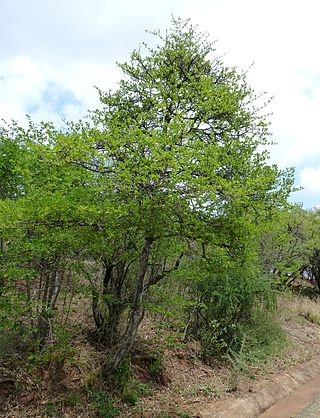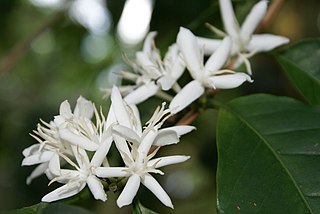Related Research Articles

Rubiaceae is a family of flowering plants, commonly known as the coffee, madder, or bedstraw family. It consists of terrestrial trees, shrubs, lianas, or herbs that are recognizable by simple, opposite leaves with interpetiolar stipules and sympetalous actinomorphic flowers. The family contains about 13,500 species in about 620 genera, which makes it the fourth-largest angiosperm family. Rubiaceae has a cosmopolitan distribution; however, the largest species diversity is concentrated in the tropics and subtropics. Economically important genera include Coffea, the source of coffee, Cinchona, the source of the antimalarial alkaloid quinine, ornamental cultivars, and historically some dye plants.

Basilicum is a genus of plants in the family Lamiaceae, first described in 1802. It contains only one known species, Basilicum polystachyon, native to Africa, Madagascar, southern Asia, New Guinea, Australia, and various islands of the Pacific and Indian Oceans.
John Patrick Micklethwait Brenan (1917-1985) was a British botanist who became director of the Royal Botanic Gardens, Kew.

Bullockia is a genus of flowering plants in the family Rubiaceae. It was originally described as a subgenus of Canthium. The genus is distributed in eastern and southern Africa from Ethiopia to Transvaal, as well as Madagascar in bushland, woodland, savannas, and dry, deciduous forests.

Canthium is a genus of flowering plants in the family Rubiaceae. They are shrubs and small trees. The leaves are deciduous and the stems are usually thorny.
Keetia is a genus of flowering plants in the family Rubiaceae. It consists of climbers or scrambling shrubs, rarely small trees.
Multidentia is a genus of flowering plants in the family Rubiaceae.

Psydrax is a genus of flowering plants in the family Rubiaceae. It consists of trees, shrubs, and a few lianas in the paleotropics.

Bernard Verdcourt was a biologist and taxonomist, most widely known as a botanist and latterly an honorary research fellow at the Royal Botanic Gardens, Kew in London. Prior to coming to Kew in 1964, he was associated with the East African Herbarium for 15 years. Although his best-known work probably consists of his many studies of the East African flora, he has also made extensive contributions relating to African terrestrial mollusks and to entomology. Dr. Verdcourt received the Linnean Medal for botany from the Linnean Society of London in 2000. His list of publications includes more than 1,000 scientific works. The standard author abbreviation Verdc. is used to indicate this person as the author when citing a botanical name.

Vanguerieae is a tribe of flowering plants in the family Rubiaceae and contains about 655 species in 30 genera. It is one of the most species-rich groups within the family and it is distributed across the Paleotropics.

Afrocanthium is a genus of flowering plants in the family Rubiaceae. It consists of deciduous, unarmed trees, and shrubs. They are native to East Africa, from Sudan and Ethiopia to South Africa.

Meyna is a genus of flowering plants in the family Rubiaceae.
Fadogiella is a small genus of flowering plants in the family Rubiaceae. It was described by Walter Robyns in 1928.
Elizabeth Jill Cowley is a British botanist, who has worked at the Royal Botanic Gardens, Kew. Her interests have included the tropical flora of East Africa and the genus Roscoea.

Maureen Elizabeth Church is a Welsh-born botanist and a self-trained botanical illustrator. Her preferred technique was that of line drawings and her work is in the permanent collections of the Forest Herbarium in Oxford, the East African Herbarium in Nairobi, the Herbarium at Kew, and the University of Edinburgh.

Coffeeae is a tribe of flowering plants in the family Rubiaceae and contains about 333 species in 11 genera. Its representatives are found in tropical and southern Africa, Madagascar, the western Indian Ocean, tropical and subtropical Asia, and Queensland.
Adenodolichos baumii is a plant in the legume family Fabaceae, native to tropical Africa.
Adenodolichos exellii is a plant in the legume family Fabaceae, native to tropical Africa.
Adenodolichos rhomboideus is a plant in the legume family Fabaceae, native to tropical Africa.

Coffea racemosa, also known as racemosa coffee and Inhambane coffee, is a species of flowering plant in the family Rubiaceae. It has naturally low levels of caffeine, less than half of that found in Coffea arabica, and a quarter of that in Robusta coffee.
References
- 1 2 "Bridson, Diane Mary (1942-)". International Plant Names Index. Archived from the original on 28 July 2019.
- ↑ "Bridson, Diane M." Royal Botanic Gardens, Kew. Archived from the original on 20 January 2012.
- ↑ "Kew Staff List". The Journal of the Kew Guild. 8: 1032–1035. 1970. Archived from the original on 29 January 2023. Retrieved 8 April 2021– via ISSUU.
- ↑ Woodhams, J R (2003). "News of Kewites at home and abroad in 2002". The Journal of the Kew Guild. 14: 157. Archived from the original on 22 March 2023. Retrieved 8 April 2021– via ISSUU.
- ↑ "News Release - Kew Course for Overseas students receives 'Darwin' grant". The Journal of the Kew Guild. 11: 296. 1994. Archived from the original on 22 March 2023. Retrieved 8 April 2021– via ISSUU.
- ↑ "Nature Safaris". HUG - Ham United Group. 2020. Archived from the original on 13 August 2020.
- ↑ Myers, Robin (22 February 2008). "Gavin Bridson: Bibliographer and librarian". Independent.
- ↑ Verstraete B, Steyn H, Van Wyk B (2018). "Taxonomic status of some geofrutex members of Vanguerieae (Rubiaceae): notes on Eriosemopsis and Pygmaeothamnus and the description of a new genus Bridsonia". Botanical Journal of the Linnean Society. 186 (1): 47–65. doi:10.1093/botlinnean/box076.
- ↑ Wong KM, Mahyuni R, Ng XY, Neo L (2018). "Flora of Singapore precursors, 8. Systematy of the new Southeast Asian genera Canthiumera and Dibridsonia (Rubiaceae: Vanguerieae), with notes on plant architecture and reproductive ecology". Reinwardtia. 17: 101–124. doi: 10.14203/reinwardtia.v17i2.3648 .